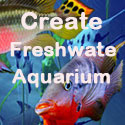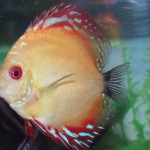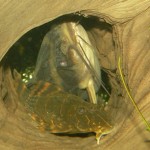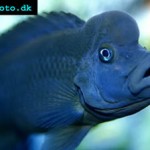A Congo River Aquarium:
This richly planted tropical fish tank allows aquarists to travel to the heart of Africa, into the currents of the Congo river, from the comfort of our very own homes. This 200-litre aquarium will be housed by 8 Congo tetras, 2 reedfish, 4 elephantnose fish and 2 pairs of peaceful African blockheads, all of which happily swimming in and around the roots of anubius barteri.
Required Material:
A 200-litre fish tank.
A stand designed for supporting fish tanks.
A sheet of 10mm thick polystyrene.
10kg of fine river gravel.
A 100-watt water heater to maintain a stable temperature of 25.5 degrees celcius.
An internal filter with a flow capacity of 200 liters per hour.
A ceramic airstone connected to a small air pump.
A Grolux light tube.
A small net.
A small bucket (optional).
A small gravel cleaner (optional).
Required Plants and Decor:
4 Anubias heterophylia.
5 Anubias barteri.
2 Anubias barteri ‘Nana’.
3 Anubias congensis.
2-3 small roots.
A small bag of non-calcareous rocks.
A poster for the back of your aquarium (optional).
Required Fish:
8 phenacogrammus interruptus (Congo tetra).
2 pairs of Steatocranus casuarius (African blockhead).
4 Gnathonemus petersii (Elephantnose).
2 Erpetoichthys calabaricus (reedfish).
Required Food:
Live food (they love brine shrimp and bloodworms!).
Frozen food.
Flake food.
Pellet food.
Installation Process:
Build and/or place your stand in its desired location.
Place the 10mm thick polystyrene sheet on top of your stand.
Place your aquarium on top of the 10mm thick polystyrene sheet.
Attach your poster to the back wall of your tank.
Arrange the roots and rocks in the tank so there is plenty space available for the fish to swim freely, taking into account also that the roots of anubias must be wedged between the crevices of the rocks so as to avoid it rotting.
Thoroughly wash the gravel to reduce the dust.
Spread the gravel across the bottom of your tank so there is a slight slope descending from the back to the front.
Place the airstone at the back of your tank.
Fill the tank two-thirds full with water (aiming for the ideal values of between 8 and 15 dH, between 5 and 10 KH and a pH of roughly 7.0).
Begin planting the different species of anubias (remembering not to bury the roots!) in a semi-circle around the tank, leaving the front of the tank free for swimming.
Fill the tank with the final third of water.
Insert the internal filter, preferably hidden in one of the back corners.
Attach the heater to the back wall of your aquarium (unless you can hide it inside the filter).
Connect the air pump to the tube which links it to the airstone.
Make sure all electrical equipment is safe before switching on!
Leave your tank to settle for the next 15-20 days.
To speed up the process of your tank, you can at this point add denitrifying bacteria, which will enable the biological balance to be established in just a few days which, in turn, will allow you to add your fish quicker (optional).
After the 15-20 days, go buy your fish!
Float the bags containing your fish in your tank for roughly 20 minutes.
In order to avoid shocking them (which can kill them!) you should introduce some water from your aquarium into the bags slowly, at a rate of roughly a glassful every couple of minutes.
After floating in your aquarium for roughly 20 minutes, use your net to transfer the fish into their new home.
Required Maintenance:
Feed your fish twice daily, alternating between the live, frozen, flake and pellet foods. This selection of tropical fish will prefer some live brine shrimp or live bloodworms but it is a very good strategy to mix their diet.
Replace roughly 25% of the tanks water with fresh water every 2 weeks.
Adding a liquid fertilizer after adding the fresh water will give the plants a massive boost.
Clean the filter media once every six weeks.
Regular care of the plants (removal of dead leaves, pruning etc.) is a must to keep the tank looking aesthetically pleasing.
Clean the front pane of glass as and when required.
















